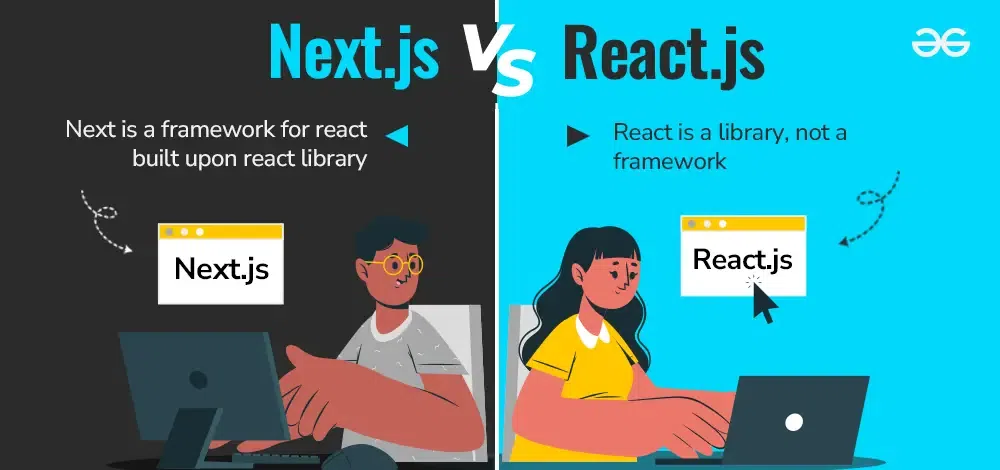Highlights
- Next.js boosts performance and SEO with server-side rendering (SSR) and static site generation (SSG).
- Automatic code splitting in Next.js improves load times by breaking code into smaller, load-on-demand bundles.
- React’s component-based architecture allows the building of reusable UI elements, making complex interfaces manageable.
- Next.js includes built-in features like routing and CSS support, simplifying setup and development.
- React may not be ideal for projects needing real-time updates or those with limited JavaScript support.
The JavaScript world is constantly changing. New ideas and solutions are being developed daily, leading to the creation of new tools.
React has become the most popular library or framework among developers, making it the first choice for many new JavaScript developers. But here’s something to think about: Next.js is also built on the React library. So, what’s the difference between the two, and why does it matter?
In this article, we’ll explore React and Next.js, two of the most popular JavaScript frameworks. We’ll also discuss why it is important to use Nextjs over Reactjs to help you understand which one might be better for your needs.
What is Next.js?

Next.js is an open-source framework for React designed to make building modern web applications easier. It comes with built-in features that improve performance and SEO for React applications. These features include server-side rendering (SSR), static site generation (SSG), automatic code splitting, and routing.
What are Next.js Features?
- Server-Side Rendering (SSR): React components are displayed on the server before being sent to the client, enhancing performance and SEO. This differs from client-side rendering, which happens in the user’s browser.
- Static Site Generation (SSG): Generates static HTML files at build time, which are served to users without needing a server. This is great for content-heavy sites or pages that don’t change often.
- Automatic Code Splitting: This breaks your code into smaller bundles that load only when needed. This speeds up the initial load time of your application.
- Routing: Uses a file-based routing system where each React component represents a route, simplifying the creation and management of complex routes.
- API Routes: This lets you create serverless functions to handle data fetching or server-side tasks.
- Built-in CSS and Sass Support: Supports styling your application with CSS or Sass out of the box, making it easy to use popular styling solutions.
What is Next.js Not Good For?
Next.js is great for server-side rendering, static site generation, and performance improvements. However, it might not be the best choice for all projects. Here are some cases where Next.js might not be suitable:
- Microservices or Backend-Heavy Applications: Next.js is mainly for front-end development. If your project involves complex backend logic or microservices, you might want to use backend-focused frameworks like Express.js, Nest.js, or Spring Boot.
- Real-Time Applications: For applications that need real-time updates, like chat apps or multiplayer games, Next.js may not be ideal. It can handle real-time updates but can’t manage real-time connections or handle many concurrent requests.
- Highly Customized User Interfaces: If your project needs intricate animations, interactions, or complex layouts, Next.js might be limiting. While it provides a solid foundation, its built-in conventions could restrict your ability to create highly customized designs. In such cases, React with a lightweight bundler like Webpack or a specialized UI library might be a better choice.
What is React.js?

React.js, also known as React, is a widely used JavaScript library for building UI developed by Facebook. It was first released in 2013 and has become widely used for creating web applications.
React.js helps developers build reusable UI components that include their logic and state. This makes it easier to manage complex UI by breaking them down into manageable pieces.
What are the Key Features of React?
- Component-Based Architecture: React allows you to build UIs with reusable components. Each component manages its logic, state, and appearance. This makes building and maintaining complex interfaces easier.
- Declarative Syntax: React uses this approach to describe how the UI should look at any time, rather than manually updating the DOM. This makes your code more understandable and easier to manage.
- Virtual DOM: React uses a virtual DOM to improve performance. Instead of changing the browser’s DOM directly, React updates a virtual version of the DOM. Then, efficiently apply those changes to the real DOM.
- Unidirectional Data Flow: React data flows from parent to child components via props. This makes tracking changes and how data moves through your application easier.
- JSX: React uses JSX (JavaScript XML), which lets you write HTML-like code within JavaScript. This makes it easier to design and visualize UI components and integrate JavaScript logic into your markup.
- Hooks: Introduced in React 16.8, Hooks allows you to use state and other features in functional components, not just class components. They help you write cleaner, more concise code and reuse logic across components.
- Cross-Platform: React is used not only for web applications but also for mobile apps through React Native. It also lets you build mobile apps using React and JavaScript, which are then compiled into native code for iOS and Android.
When Not to Use React?
React relies on JavaScript for rendering and interactivity, so it might not be the best choice in some situations:
- Limited JavaScript Support: If your target audience includes users with limited JavaScript capabilities, such as those using screen readers or environments where JavaScript is restricted, React might not be ideal. You may need alternative solutions to ensure accessibility and provide fallback options.
- Real-Time Applications: More than React alone, it might be needed for applications that need real-time updates, like chat apps or multiplayer games. While React can handle real-time updates with client-side JavaScript, it’s not designed to manage real-time connections or handle many concurrent requests efficiently. In such cases, frameworks like Socket.io or platforms like Firebase might be better suited.
Why Use Nextjs over Reactjs?
Next.js is a great choice over React in several situations:
- Server-Side Rendering and Static Site Generation: If you need your application to render content on the server for better performance, SEO, or quicker initial page loads, Next.js is ideal. It’s especially useful for content-heavy websites, blogs, or e-commerce sites where SEO is important.
- Improved Performance: Next.js pre-renders pages at build time or on the server, which can reduce the amount of JavaScript the client needs to download and run. This leads to faster load times and a better experience, particularly on slower devices or networks.
- Built-In Features: Next.js includes automatic code splitting, CSS and Sass support, and API routes. If you need these features and want to avoid setting them up yourself, Next.js can save you time and effort.
Can Nextjs Be Used with React?
Yes, you can use Next.js with React. Next.js is built on top of React. To use Next.js with React, you follow a process similar to creating a React application but take advantage of Next.js features like server-side rendering (SSR), static site generation (SSG), and routing. This way, you benefit from React’s component-based architecture and Next.js’s additional capabilities.
Summary
Understanding why to use Nextjs over Reactjs can help you make an informed choice for your custom web development needs. Next.js offers built-in features for server-side rendering, static site generation, and automatic code splitting. On the other hand, React provides a foundation for building dynamic UI components. By evaluating the strengths of Next.js and React, you can choose the best tool to create high-performing, scalable web applications.






